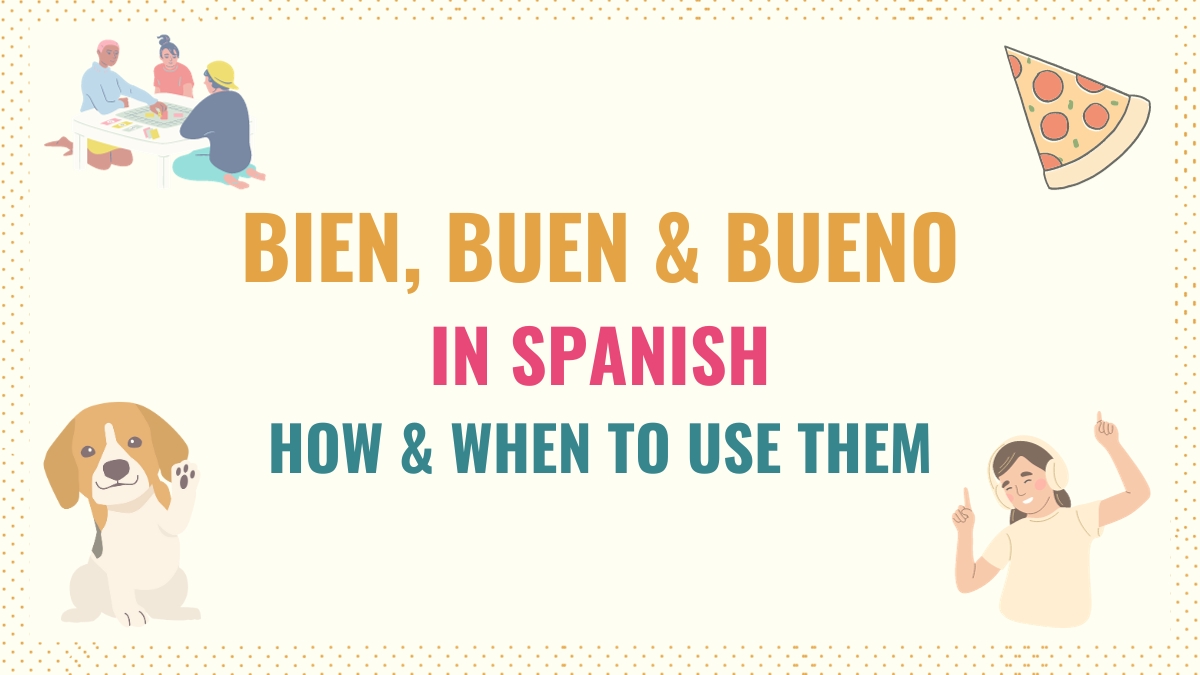When learning Spanish non-native Spanish speakers tend to confuse ‘bien’, ‘buen’ and ‘bueno’ because their meaning is quite similar. Since they are not interchangeable, using one instead of the other will affect your fluency in Spanish.
- When to use bien, buen & bueno
- Video Lesson
- When to use bien
- Bueno(s) and buena(s)
- When to use buen
- Key Points
Short Answer
‘Bien’ means ‘well’ or ‘fine’ and is used to describe an action or emphasize an adjective or another adverb. ‘Bueno’ and ‘buen’ mean ‘good’. They describe people, activities or objects, but ‘buen’ conveys a person’s opinion or judgment.
In this article, we are going to discuss the difference between these words as well as their most common uses in Spanish. Hopefully, by the end of this post, you may have a clearer understanding of ‘bien’, ‘buen’ and ‘bueno’.
When to use ‘bien’, ‘buen’ and ‘bueno’
One of the main differences between ‘bien’, buen’ and ‘bueno’ are the type of words they work with. As an adverb of manner, bien is used to describe how an action is performed. Additionally, it also intensifies the qualities conveyed by adjectives and other adverbs. For example:
| ¡Hablas español muy bien! | You speak Spanish very well! |
| Tomás corre bien rápido. | Tomas runs really fast. |
‘Buen’ and ‘bueno’ are adjectives that describe nouns like people, things, or places. Unlike ‘bien,’ they must agree in gender and number with the nouns they modify.
‘Bueno’ means ‘good’ and typically follows the noun it describes. On the other hand, ‘buen’ also means ‘good’ but always precedes the noun and reflects a subjective opinion. For example:
| Juan es buen hombre. | Juan is a nice man. |
| Juan es un hombre bueno. | Juan is a good man. |
Watch the Video Lesson
Watch the Spanish Immersion Lesson!
You can also watch my immersion video to learn the differences between bien and bueno completely in Spanish.
When to use ‘bien’ in Spanish
As mentioned before, ‘bien’ is the Spanish adverb for ‘well’ and ‘fine’. In Spanish, we use this word in the same contexts that you would use ‘well’ and ‘fine’. Here are some of its most common uses as well as some rules to keep in mind.
Using ‘bien’ to describe a verb
An adverb is a word that describes how people are doing an action, therefore, they work with verbs. In Spanish, ‘bien’ goes after the verb. Hence, this is the structure you should be using.
Subject + verb + bien
| Ana cocina bien | Ana cooks well |
| Karina no habla bien inglés | Karina doesn’t speak English well |
Using ‘bien’ to describe an adjective or an adverb
Just like any other adverb, ‘bien’ also works with adjectives and other adverbs. In this case, its main function is to emphasize the characteristics the adjective is emphasizing or the action that the adverb is describing. Therefore, in this situation, ‘bien’ is the translation of ‘very’, ‘really’ or ‘quite’.
Subject + verb + bien + adjective/adverb
| Sebastián es bien grosero | Sebastian is very rude. |
| Karina habla bien rápido | Karina speaks really fast |
This structure is appropriate in informal Spanish, as a result, you may hear it or use it in verbal conversations.
Take Note: ‘Bien’ is often used with the verb estar to describe well-being (a condition or state) of a person, thing or situation at the moment of speaking. However, it can only be used with ser to describe the qualities and characteristics of people or things (nouns).
Incorrect
La película es bien. The movie is well.
Correct
La película es buena. The movie is good.
| Tu hermano es bien grosero. | Your brother is very rude. |
| Mi carro es bien rápido. | My dog is really fast. |
When to use ‘bueno’, ‘buenos’, ‘buena’ and ‘buenas’
As mentioned before, ‘bueno’ is the translation for ‘good’. Unlike ‘bien’, ‘bueno’ is an adjective which means it has plural and feminine forms. Furthermore, ‘bueno’ is a word that we use to describe a noun. This word is placed after the noun.
Esta tienda tiene precios muy buenos.
This store has very good prices.
Mi vecina es buena con los niños.
My neighbor is good with children.
Las enchiladas están bien buenas.
The enchiladas are very good.
In this last example, we can see ‘bien’ and ‘bueno’ working together. ‘Bueno’ is giving a positive description of a noun and ‘bien’ is emphasizing that information.
Uses of ‘bueno’
In the previous section, we discussed some of the differences between ‘bueno’ and ‘bien’. Now it is time to learn some other uses for you to apply this word.
1. To answer the phone

In Mexico, people use the word ‘¿bueno?’ when they answer the phone. In this case, ‘¿bueno?’ would be translated as ‘hello?’ or ‘hi?’. Just as ‘hello’ or ‘hi’, we only use ‘¿bueno?’ when the call is personal or informal.
2. As a synonym of ‘Okay’ or ‘Well’.
‘Bueno’ is also the translation of the word ‘okay’ when agreeing with someone. Furthermore, in Spanish, we use ‘bueno’ as a filler word that is when we are making a pause in our speech or when we want to buy some time to think. In this case, it would be translated as ‘well’.
| Bueno, te veo a las 10. | Okay. I’ll see you at 10. |
| Bueno… eso no es lo que quise decir. | Well… that’s not what I meant. |
3. Describes Quality or Personality
The primary use of ‘bueno’ is to describe someone’s personality or the quality of an object. In such cases, ‘bueno’ often pairs with the verb ‘ser.’ For example:
Jaime es un hombre bueno.
Jaime is a good man.
Lee este libro, es muy bueno.
Read this book, it’s very good.
Mi clase de yoga es buena.
My yoga class is good.
4. To express that someone is good at something.
Another common use of adjective ‘bueno’ is to express that a person is good at something. Here are the elements you need to form this meaning:
Subject + [ser] + bueno + para + [noun/infinitive]
Sandra es buena para las matemáticas.
Sandra is good at mathematics.
No somos buenas para cocinar.
We are not good at cooking.
Take Note: Estar is only used with bueno to either describe that food tastes good and as an informal expression to say that a person is physically attractive (hot).
¡Mira! ¿Ya viste qué buena está esa chava?
Look! Did you see how hot that girl is?
Estos tacos están muy buenos.
These tacos are very good.
When to use ‘buen’
Like ‘bueno’, ‘buen’ is also an adjective and, therefore, it follows the same rules: it must agree in number and gender with the noun that is describing. However, unlike ‘bueno’, ‘buen’ always goes before the noun and it means ‘good’ or ‘nice’.
Andrés es un buen hombre.
Andrés is a nice man.
Eres una buena amiga.
You are a good friend.
María y Andrea son buenas maestras.
María and Andrea are good teachers.
Buen and its different forms express and emphasizes the speaker’s personal perspective about the thing or person being described.
Creo que es una buena idea.
I think it’s a good idea.
No es un buen libro, no lo lea.
It’s not a good book, don’t read it.
Amalia es una buena amiga.
Amalia is a good friend.
Notice that these previous examples are based on a person’s opinion. The fact that someone thinks that a movie or book is good doesn’t mean that all people are going to share that same opinion.
As a synonym of ‘a lot’
In informal Spanish, people use the word ‘buen’ as a synonym of ‘a lot’. However, in this case, you have to add the following elements to your sentence.
Verb + un + buen + noun
Tengo un buen de trabajo.
I have a lot of work.
Compré un buen de dulces.
I bought a lot of candies.
Carlos gana un buen de dinero.
Carlos wins a lot of money.
Key Points
Bien, buen, and bueno are easily confused words due to their similarities. In this post, we discussed the differences between these words, their common uses and the elements with which they work. Here are some key points to keep in mind:
- Bien is an adverb, so it only describes verbs, adjectives or other adverbs.
- It’s translated as ‘well’ or ‘fine’.
- Bueno is an adjective and it goes after a noun. It means ‘good’ and we use it to describe the personality of a person or the quality of objects and activities.
- Bueno has feminine, masculine and plural forms – bueno(s) and buena(s) – which must agree with the adjective it’s describing.
- Buen is also an adjective and is placed before the noun. Depending on the context, it could be translated as ‘good’ or ‘nice’.
- Use it to express & emphasize an opinion about a situation, person or thing.



